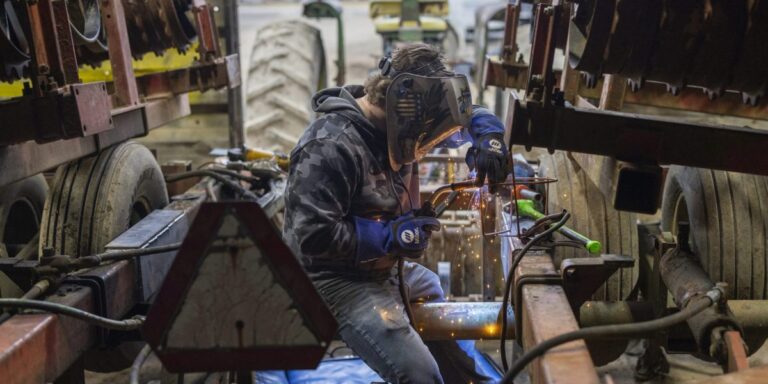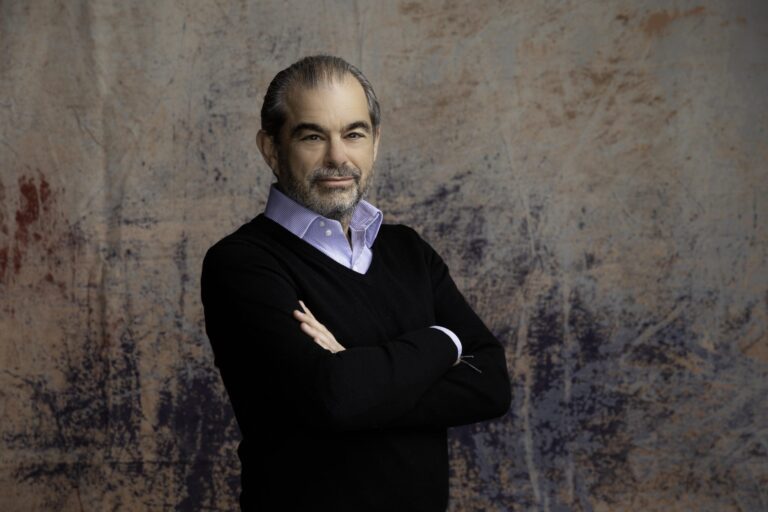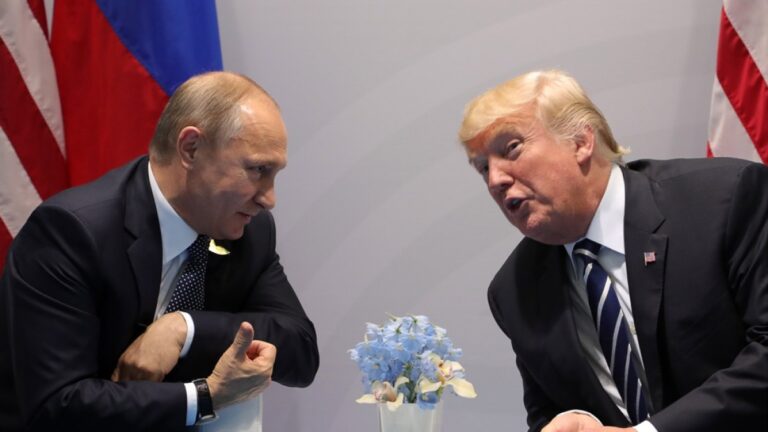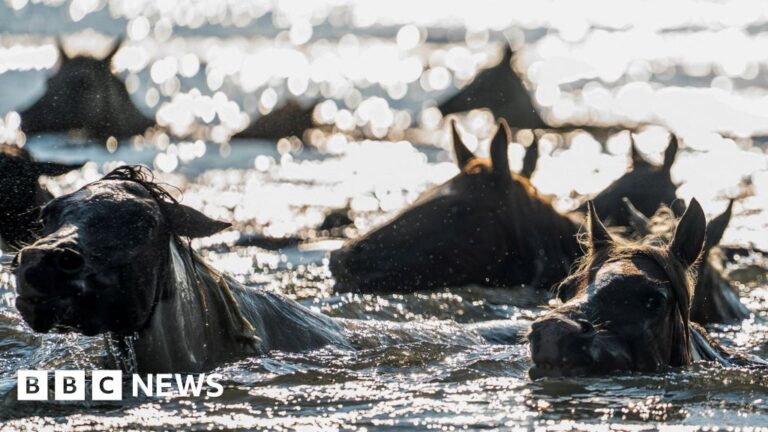US envoy tells Israeli hostage families he is working on plan to end Gaza War
Police locate getaway vehicle belonging to army veteran suspected in fatal assault
Police have found the getaway car of a US military veteran who walked into a bar in the western state of Montana on Friday morning and fatally shot four people, but the gunman remains at large.
The shooting happened at The Owl Bar in the city of Anaconda at around 10:30 local time, the Montana Division of Criminal Investigation said. The bar owner told AP news agency he thinks the suspect just “snapped”.
Police said they have found the white Ford-150 pick-up truck that the suspect used to flee the scene, but no sign of the gunman.
Authorities are now focusing their search in a mountainous area west of Anaconda, and have asked residents in the area to stay home and lock their doors.
The Anaconda-Deer Lodge County Law Enforcement Center named the suspect as Michael Paul Brown in a social media post, adding he is “believed to be armed and dangerous”.
According to public records, he lived next door to the bar.
The owner of The Owl Bar, David Gwerder, who was not there at the time of the shooting, told the Associated Press: “He knew everybody that was in that bar.
“I guarantee you that. He didn’t have any running dispute with any of them. I just think he snapped.”
The suspect is a veteran of the US Armed Forces, a spokeswoman for the Army told US media. Lt Col Ruth Catsro said Mr Brown served as an armour crewman from 2001-05, and was deployed to Iraq from 2004-05.
“If seen do not approach,” the Anaconda-Deer Lodge County Law Enforcement Center said of the suspect. “Contact 911 for any way to contact Michael Paul Brown.”
At the time of the incident, the US Bureau of Alcohol, Tobacco, Firearms and Explosives (ATF) said it was “responding to a shooting where multiple parties have been shot at a business in Anaconda”.
In an update on Friday evening, police said the victims had been identified, but their names would not be released until their families were notified.
Kelly DeRieux, a barmaid at Jodi’s Cantina and Sports Bar three blocks away from The Owl Bar, told BBC News over the phone that many businesses in town had shut down for the day.
A friend told her that heavily armed police came to her home, and “asked them to please say away from windows and lock their doors”.
Her restaurant remains open for now. “We have emergency precautions, if needed,” she said.
The Granite County Sheriff’s Office, which is nearby to Anaconda, posted on social media that the gunman was “said to be wearing a tye-dyed shirt, blue jeans and a orange bandana”.
The sheriff’s office added that the gunman’s home in Anaconda had been searched, and “cleared by SWAT” teams.
Anaconda is a former copper smelting hub, with a population of almost 10,000 people in south-western Montana, 109 miles (175km) west of Bozeman.
Montana Governor Greg Gianforte said he was monitoring the response to the incident.
“Please join Susan and me in praying for the victims, their loved ones, and the brave law enforcement officers responding to this tragedy,” the governor said on social media referring to his wife, Susan Gianforte.
The FBI was also at the scene helping in the investigation.
Montana Senator Steve Daines told local media that the “massive manhunt” was being aided by police drones.
The Owl Bar was built in 1893 to serve Anaconda’s copper workers, according to a 1987 article in the Montana Standard newspaper. It’s located in a neighbourhood of Anaconda called Goosetown.
For Gen Zers in rural counties, choosing a career path is more stressful than finding one without a college degree.
As a student in western New York’s rural Wyoming County, Briar Townes honed an artistic streak that he hopes to make a living from one day. In high school, he clicked with a college-level drawing and painting class.
But despite the college credits he earned, college isn’t part of his plan.
Since graduating from high school in June, he has been overseeing an art camp at the county’s Arts Council. If that doesn’t turn into a permanent job, there is work at Creative Food Ingredients, known as the “cookie factory” for the way it makes the town smell like baking cookies, or at local factories like American Classic Outfitters, which designs and sews athletic uniforms.
“My stress is picking an option, not finding an option,” he said.
Even though rural students graduate from high school at higher rates than their peers in cities and suburbs, fewer of them go on to college.
Many rural school districts, including the one in Perry that Townes attends, have begun offering college-level courses and working to remove academic and financial obstacles to higher education, with some success. But college doesn’t hold the same appeal for students in rural areas where they often would need to travel farther for school, parents have less college experience themselves, and some of the loudest political voices are skeptical of the need for higher education.
College enrollment for rural students has remained largely flat in recent years, despite the district-level efforts and stepped-up recruitment by many universities. About 55% of rural U.S. high school students who graduated in 2023 enrolled in college, according to National Clearinghouse Research Center data.That’s compared to 64% of suburban graduates and 59% of urban graduates.
College can make a huge difference in earning potential. An American man with a bachelor’s degree earns an estimated $900,000 more over his lifetime than a peer with a high school diploma, research by the Social Security Administration has found. For women, the difference is about $630,000.
A school takes cues from families’ hopes and goals
A lack of a college degree is no obstacle to opportunity in places such as Wyoming County, where people like to say there are more cows than people. The dairy farms, potato fields and maple sugar houses are a source of identity and jobs for the county just east of Buffalo.
“College has never really been, I don’t know, a necessity or problem in my family,” said Townes, the middle of three children whose father has a tattoo shop in Perry.
At Perry High School, Superintendent Daryl McLaughlin said the district takes cues from students like Townes, their families and the community, supplementing college offerings with programs geared toward career and technical fields such as the building trades. He said he is as happy to provide reference checks for employers and the military as he is to write recommendations for college applications.
“We’re letting our students know these institutions, whether it is a college or whether employers, they’re competing for you,” he said. “Our job is now setting them up for success so that they can take the greatest advantage of that competition, ultimately, to improve their quality of life.”
Still, college enrollment in the district has exceeded the national average in recent years, going from 60% of the class of 2022’s 55 graduates to 67% of 2024’s and 56% of 2025’s graduates. The district points to a decision to direct federal pandemic relief money toward covering tuition for students in its Accelerated College Enrollment program — a partnership with Genesee Community College. When the federal money ran out, the district paid to keep it going.
“This is a program that’s been in our community for quite some time, and it’s a program our community supports,” McLaughlin said.
About 15% of rural U.S. high school students were enrolled in college classes in January 2025 through such dual enrollment arrangements, a slightly lower rate than urban and suburban students, an Education Department survey found.
Rural access to dual enrollment is a growing area of focus as advocates seek to close gaps in access to higher education. The College in High School Alliance this year announced funding for seven states to develop policy to expand programs for rural students.
Higher education’s image problem is acute in rural America
Around the country, many students feel jaded by the high costs of college tuition. And Americans are increasingly skeptical about the value of college, polls have shown, with Republicans, the dominant party in rural America, losing confidence in higher education at higher rates than Democrats.
“Whenever you have this narrative that ‘college is bad, college is bad, these professors are going to indoctrinate you,’ it’s hard,” said Andrew Koricich, executive director of the Alliance for Research on Regional Colleges at Appalachian State University in North Carolina. “You have to figure out, how do you crack through that information ecosphere and say, actually, people with a bachelor’s degree, on average, earn 65% more than people with a high school diploma only?”
In much of rural America, about 21% of people over the age of 25 have a bachelor’s degree, compared to about 36% of adults in other areas, according to a government analysis of U.S. Census findings.
Some rural educators don’t hold back on promoting college
In rural Putnam County, Florida, about 14% of adults have a bachelor’s degree. That doesn’t stop principal Joe Theobold from setting and meeting an annual goal of 100% college admission for students at Q.I. Roberts Jr.-Sr. High School.
Paper mills and power plants provide opportunities for a middle class life in the county, where the cost of living is low. But Theobold tells students the goal of higher education “is to go off and learn more about not only the world, but also about yourself.”
“You don’t want to be 17 years old, determining what you’re going to do for the rest of your life,” he said.
Families choose the magnet school because of its focus on higher education, even though most of the district’s parents never went to a college. Many students visit college campuses through Camp Osprey, a University of North Florida program that helps students experience college dorms and dining halls.
In upstate New York, high school junior Devon Wells grew up on his family farm in Perry but doesn’t see his future there. He’s considering a career in welding, or as an electrical line worker in South Carolina, where he heard the pay might be double what he would make at home. None of his plans require college, he said.
“I grew up on a farm, so that’s all hands-on work. That’s really all I know and would want to do,” Devon said.
Neither his nor Townes’ parents have pushed one way or the other, they said.
“I remember them talking to me like, `Hey, would you want to go to college?’ I remember telling them, ‘not really,’” Townes said. He would have listened if a college recruiter reached out, he said, but wouldn’t be willing to move very far.
Protesters in Bangkok Rally Against Prime Minister Paetongtarn
new video loaded: Thais Rally in Bangkok to Denounce Prime Minister Paetongtarn
The protesters say Prime Minister Paetongtarn Shinawatra sold out Thailand and betrayed its army in a leaked phone conversation with Cambodia’s de facto leader.
Recent episodes in Asia Pacific
SESAC Music Group successfully raises $889 million through whole business securitization, with demand exceeding three times the original offering amount.
US-based SESAC Music Group (SMG) has completed a USD $889 million whole business securitization (WBS), marking the company’s fourth trip to the asset-backed securities market.
The news arrives as music companies increasingly turn to the bond market to fund growth.
US-headquartered SMG – home to the SESAC PRO, plus Harry Fox Agency (HFA), AudioSalad, and other companies – issued the bonds through a series of new five-year senior notes.
These notes are backed by “substantially all SESAC Music Group’s assets and revenues,” according to SMG – including subsidiaries in its Performing Rights and Music Services divisions.
SESAC’s Performing Rights division represents songwriters such as Ariana Grande, Kurt Cobain, Jack Harlow, Billie Joe Armstrong, and Axl Rose, and composers of music in TV shows like Seinfeld, Grey’s Anatomy, Suits, and Modern Family, and films like Cars 3, Ant-Man and the Wasp, Frozen, and Napoleon Dynamite.
Meanwhile, the company’s Music Services arm offers copyright administration, licensing, and royalty collection services for rightsholders worldwide via subsidiaries such as AudioSalad, Mint, Audiam, HFA, and Rumblefish.
The new WBS transaction brings the total outstanding debt of SESAC, which is majority-owned by Blackstone, to about $1.1 billion.
The securitization received strong investor interest, with demand three times oversubscribed. SESAC said this reflected “robust investor demand underpinning SESAC’s WBS strategy.”
MBW understands that SESAC Music Group executed its first tranche of whole business securitization in 2019, securing between $500 million and $600 million.
That was followed by a second tranche for $335 million in 2022. Last year, SESAC raised another $180 million through securitization.
Rather than securing finance backed by assets such as music rights – like Concord‘s recent $1.77 billion ABS – SESAC Music Group structures its debt by securitizing its entire company’s operation.
Comparisons to a mortgage-like structure on private property are not unwarranted.
“As we continue to expand both segments of our business, ensuring long-term access to institutional capital, and continuing to build upon our strong financial foundation and established reputation are crucial.”
John Josephson, SESAC Music Group
SESAC partly employs the practice of whole business securitization to help bankroll its acquisitions.
For example, the firm used previous WBS proceeds to help finance its acquisition of production music company Audio Network in 2021.
SESAC Music Group Chairman and CEO, John Josephson, said of SESAC’s latest WBS transaction: “As we continue to expand both segments of our business, ensuring long-term access to institutional capital, and continuing to build upon our strong financial foundation and established reputation are crucial.
“WBS transactions like the one we just closed will remain a vital part of our growth strategy, allowing us to continue to lower our cost of capital while expanding our global capabilities in support of the independent songwriters, composers, publishers, labels, artists and CMOs we serve.”
The timing of SESAC’s latest WBS transaction reflects a surge in music industry securitizations.
As mentioned, just last week, Concord closed a $1.765 billion bond offering backed by its 1.3 million music copyrights.
Meanwhile, Blackstone-owned Recognition Music Group disclosed plans for a $372 million issuance of five-year bonds backed by its multi-billion-dollar music catalog that includes rights from Red Hot Chili Peppers, Justin Bieber and Shakira.
SESAC says its latest WBS issuance “is the largest 144a, rated whole business securitization in the music sector to date.”
Morningstar DBRS assigned the notes a BBB(sf) rating. Guggenheim Securities, Barclays Capital, and ING Financial Markets served as joint bookrunners, while Blackstone Securities acted as co-manager.
Virtu Global Advisors provided valuation services, while Latham & Watkins provided legal counsel for SESAC and White & Case for the underwriters.Music Business Worldwide
Trump’s decision to relocate nuclear submarines following disagreement with Medvedev sparks concern in Nuclear Weapons News
Donald Trump has ordered the repositioning of two United States nuclear submarines to “appropriate regions” relative to Russia, as the US president grows frustrated over stalling peace talks aimed at bringing an end to Russia’s war in Ukraine.
On Friday, Trump exchanged heated words with Dmitry Medvedev, Moscow’s military leader and former president.
The day before, Trump had issued an ultimatum to Russia: If it does not agree to a ceasefire by next Friday, August 8, he will impose a package of economic sanctions.
The next day, Medvedev posted on social media, describing Trump’s threat as “a step towards war”. He wrote that Trump was “playing the ultimatum game with Russia”.
In a post on Truth Social, Trump responded: “Words are very important, and can often lead to unintended consequences, I hope this will not be one of those instances.”
What has Trump done?
On Friday, Trump wrote on his Truth Social platform that he had ordered two US “Nuclear Submarines” to be repositioned to “appropriate regions”.
Trump cited what he regarded as threatening comments made by former Russian President Medvedev, now deputy chair of Russia’s Security Council. He called Medvedev’s statements “highly provocative”, adding that his actions were a precaution.
“I have ordered two Nuclear Submarines to be positioned in the appropriate regions, just in case these foolish and inflammatory statements are more than just that,” Trump wrote.
In the run-up to his presidential campaign, Trump promised to end Russia’s war in Ukraine within 24 hours; however, several discussions with Russian President Vladimir Putin have since not yielded any results.
What do we know about the submarines Trump says he will reposition?
Not much – and we do not know which submarines Trump is referring to. Trump did not say if he had ordered the repositioning of submarines with nuclear engines or submarines carrying nuclear missiles.
Trump did not reveal the location of the submarines, either, as mandated by US military protocol.
However, Trump’s statement is so far being viewed as a rhetorical threat, rather than a military one, as security analysts noted that the US already has nuclear-powered submarines that are deployed and capable of striking Russia as a deterrent.
What prompted Trump’s submarine move?
Mostly, his frustration over the lack of progress of peace talks between Russia and Ukraine. But, in this case, the social media spat with Medvedev seems to have tipped him over into action.
Trump and the Russian military leader have been engaged in mud-slinging on social media platforms for some time.
Earlier, responding to Trump’s new deadline for a ceasefire in Ukraine, Medvedev wrote in a post on X that Trump was playing an “ultimatum game” with Russia.
“Each new ultimatum is a threat and a step towards war. Not between Russia and Ukraine, but with his own country. Don’t go down the Sleepy Joe road!” Medvedev had said.
Earlier in the week, while announcing trade tariffs for India – along with an extra penalty for buying Russian oil – Trump stated that he did not care if India and Russia “take their dead economies down together”.
In a Telegram post on Thursday, Medvedev wrote that Trump should “revisit his favourite movies about the living dead and recall just how dangerous the mythical ‘Dead Hand’ can be”.
Russia’s “Dead Hand system” is a Cold War-era automatic nuclear retaliation mechanism designed to launch a counterstrike even if the Russian leadership is wiped out in a first strike.
Trump replied: “Tell Medvedev, the failed former President of Russia, who thinks he’s still President, to watch his words. He’s entering very dangerous territory!”
Speaking to reporters after his post about the nuclear submarines, Trump said on Friday: “We just have to be careful. And a threat was made and we didn’t think it was appropriate, so I have to be very careful.
“A threat was made by a former president of Russia, and we’re going to protect our people.”
Who has more nuclear power: Russia or the US?
Combined, the US and Russia account for nearly 87 percent of the world’s total nuclear arsenal. The geopolitical rivals control about 83 percent of the nuclear warheads actually deployed or ready for operational use.
Despite significant post-Cold War reductions, global nuclear arsenals remain at a “very high level”, according to a report by the Federation of American Scientists. As of January 2025, just nine countries are estimated to possess a total of approximately 12,241 nuclear warheads.
Today, according to the nonprofit Arms Control Association, the US deploys 1,419 and Russia deploys 1,549 strategic warheads on several hundred bombers and missiles.
The US conducted its first nuclear test explosion in July 1945; the following month, it dropped two atomic bombs on the Japanese cities of Hiroshima and Nagasaki. Four years later, the Soviet Union conducted its first nuclear test explosion.
As of 2025, the US Navy operates 71 submarines, all nuclear‑powered, making it the largest undersea force. This fleet includes 14 Ohio‑class ballistic missile subs (SSBNs), four Ohio‑class converted guided‑missile submarines (SSGNs) loaded with Tomahawk missiles for strikes or special operations, and about 53 fast‑attack submarines designed for intelligence gathering, anti‑submarine warfare and cruise‑missile support.
By comparison, the Russian Navy fields fewer than 30 nuclear‑powered submarines, including approximately 10 strategic SSBNs, a mix of modern Borei and older Delta IV classes, that carry Bulava missiles.
It also operates several strategic‑missile cruise boats and about six Akula‑class attack submarines equipped for anti‑ship and multi‑role missions. Russia is investing in modern fleet expansion through the Yasen‑M class.

Has Russia responded to Trump’s submarine manoeuvre?
No. Neither the Kremlin nor Medvedev has publicly responded to Trump’s order to move two nuclear submarines following their war of words.
Viktor Vodolatsky, a senior Russian lawmaker and deputy chairman of the State Duma’s committee on Commonwealth of Independent States (CIS) affairs, however, stated that Russia possesses “significantly more nuclear submarines in the world’s oceans” than the US, claiming US subs have “long been under their control” and, therefore, no specific response is required.
Last month, the US President said he was “disappointed” with Putin.
“We’ll have a great conversation. I’ll say: ‘That’s good, I’ll think we’re close to getting it done,’ and then he’ll knock down a building in Kyiv,” he told the BBC in an interview.
On Friday, in an apparent reference to Trump’s comment, Putin said: “As for any disappointments on the part of anyone, all disappointments arise from inflated expectations. This is a well-known general rule.”
On a ceasefire with Kyiv, Putin said he wants a “lasting and stable peace” in Ukraine; however, he has not given any indication that Russia is willing to achieve it any quicker.
In 2017, during his first term as US president, Trump announced that he had sent two nuclear submarines to the Korean peninsula. Soon afterwards, he held a meeting with the North Korean leader, Kim Jong Un.
Whether this latest move will lead to a new meeting with Putin is yet to be seen, however.
Carson Foster Withdraws from 400 IM Prelims Due to Ankle Injury Sustained Before 200 IM Final
By Anya Pelshaw on SwimSwam

2025 World Championships
- July 27 – August 3, 2025 (pool swimming)
- Singapore, Singapore
- World Aquatics Championships Arena
- LCM (50m)
- Meet Central
- How To Watch
- SwimSwam Preview Index
- Entry Book
- Live Results
- Live Recaps
Carson Foster of the US has announced on Instagram that he is scratching prelims of the men’s 400 IM. Foster states that he “tweaked a tendon” in his ankle before the final of the men’s 200 IM.
“The stories we’ll tell one day about this meet…
Definitely a frustrating way to end the season. Before the 200 IM final, I tweaked a tendon in my ankle which has made kicking and turning very difficult. Due to this, I have pulled out of the 400 IM.
Despite the circumstances, I am always grateful for the opportunities to represent the US. One more day of competition and I’m ready to be a cheerleader in the stands!”
Foster also was a late scratch for the final of the men’s 200 IM. He was the #8 seed heading into the final but was the #3 seed coming into the meet. His only individual final of the meet came with a 5th place finish in the 200 butterfly.
He was one of the medal contenders for tomorrow’s 400 IM as he was the #2 seed with a 4:07.64 entry time. Only World Record holder Leon Marchand of France was seeded ahead of Foster with a 4:02.95.
In addition to scratching the final of the 200 IM, the injury also explains why Foster was not included in the US men’s 4×200 freestyle relay that finished 4th in a 7:01.24, just 0.26 seconds off of making the podium. Foster did not swim in prelims or finals of the relay on Friday, the day after the final of the 200 IM. He was 5th in the 200 freestyle at US Summer Nationals in a lifetime best 1:45.45.
Read the full story on SwimSwam: Carson Foster Scratching 400 IM Prelims After Tweaking Ankle Before Final Of 200 IM
Challenging the Client
A required part of this site couldn’t load. This may be due to a browser
extension, network issues, or browser settings. Please check your
connection, disable any ad blockers, or try using a different browser.
Cool Bus Shelters Designed to Counteract the Effects of Global Warming
Climate change is profoundly impacting our planet and its ecosystems, with cities being particularly vulnerable to its effects. The sheer concentration of population in urban areas and inadequate preparation for increasingly extreme climate events like heatwaves and floods make cities a critical concern. According to a recent study, by 2050, a staggering 1.6 billion people in 970 cities could be exposed to extreme temperatures. Measures such as transitioning to green power and implementing decarbonization policies are essential. However, there is a pressing need to focus on innovative technologies and initiatives specifically designed to counteract the scorching summers that continually shatter historical temperature records.
One city that is experiencing the full brunt of these extreme heatwaves is Seville, in the south of Spain. As climate change worsens the situation, the urgency to find solutions has never been greater. In response, the city is now exploring sustainable strategies, including the implementation of cooling bus shelters.
Cooling bus shelters to address climate change
Waiting for a bus in the scorching afternoon of July can expose anyone to significant thermal risks. In cities like Seville, which experienced a staggering temperature of 47.4º C in August 1946, this danger is all too familiar. However, the city council has embarked on a promising project to address this issue: the installation of innovative “climate shelters” capable of reducing temperatures by up to 20ºC. These shelters ingeniously combine cutting-edge solar energy technologies with timeless solutions like water cisterns. Representing a new generation of sustainable bus stops, these shelters are set to be a part of Seville’s urban landscape starting from 2024.
Developed by a group of researchers from the University of Seville, the new bus shelters feature four main components. First, an underground cistern stores fresh water overnight. Second, during the hottest periods of the day, the water circulates through a closed circuit that releases refreshing air through tiny holes. Third, solar panels on the shelter’s top pump water as needed. Lastly, each structure has temperature and pedestrian detection sensors to optimize performance.
During the hottest hours of the day, as a passerby approaches the bus stop, the pumping system activates, drawing water from the cistern and delivering it to the radiant element within the bus shelter, cooling down the space. This innovative system ensures that the thermal sensation inside the shelter remains between 20º and 24º C, even if the outside temperature soars above 40ºC. Afterward, the water recirculates back down to the cistern and, at night, flows through the shelter’s roof to cool down. For now, the first water tanks are being installed in one of the avenues of the Andalusian capital to start the pilot test in the summer of 2024.
The project developers hope to apply this approach to bioclimatic systems such as smart sunshades and canopies installed in school playgrounds to improve the well-being of students at recess or during sports activities.
Towards more sustainable and decarbonized cities
As cities grapple with the impacts of climate change, they must not only employ technological solutions but also take the lead in embracing sustainability and decarbonization. Apart from adopting innovative approaches to urban mobility, a pivotal aspect will involve the implementation of the Smart city concept, which will optimize the energy consumption of buildings, water management, and traffic control thanks to artificial intelligence and the Internet of Things (IoT).
One of the examples is the work carried out in another Spanish city, Gijón. One of the keys to the project undertaken in the northern city is the comprehensive and smart management of energy supply and management, both electrical and thermal, of public lighting and municipal buildings and facilities, as well as IoT technologies. These measures are estimated to reduce electricity consumption in municipal services and public lighting by 68 %, and CO2 emissions will fall by at least 30 %.
Other solutions to climate change implemented in Gijón include the replacement of diesel boilers with biomass ones, creating energy communities, or developing neighborhood self-consumption solutions. If you want to know more about other urban projects committed to energy efficiency and sustainability, look at this article about an experimental Japanese city that will combine sustainable technologies in all the mentioned areas.
Sources:
Crowds of thousands gather to witness the 100th annual wild pony swim
The Chincoteague wild ponies have made their annual swim across the Assateague Channel in Virginia for the 100th time.
The tradition began in 1925 and sees “Saltwater Cowboys” on horseback round up the ponies, who then swim the channel and come ashore on the east side of Chincoteague Island.
The event hosted by the Chincoteague Fire Department, which manages the ponies, includes an auction of some of the foals.
The money raised helps control the size of the herd to help maintain a healthy pony population on Assateague, where the ponies live most of the year.










